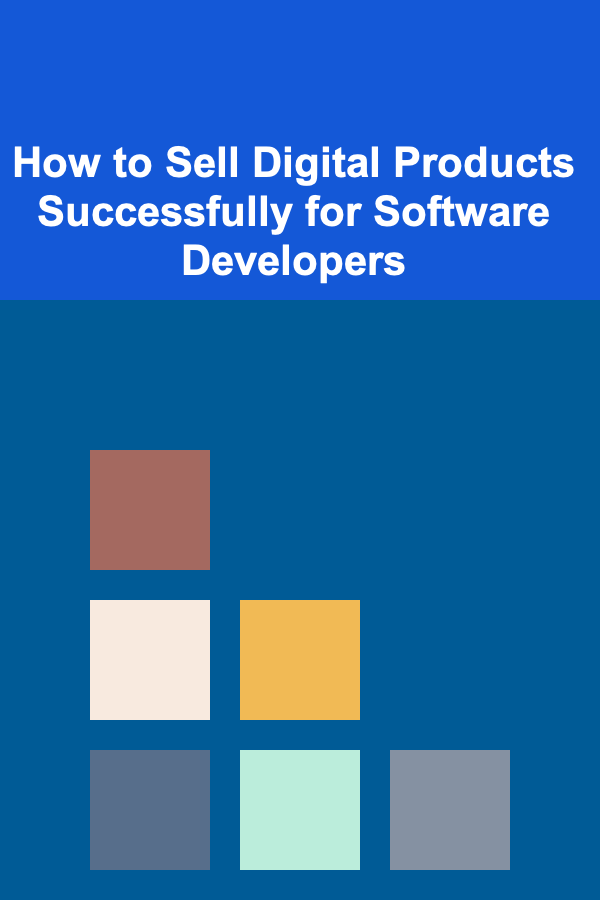
How to Sell Digital Products Successfully for Software Developers
ebook include PDF & Audio bundle (Micro Guide)
$12.99$8.99
Limited Time Offer! Order within the next:

Selling digital products has become an increasingly attractive avenue for software developers seeking to monetize their skills and expertise. Unlike traditional service-based work, selling digital products allows developers to scale their offerings, reach global audiences, and achieve financial freedom. However, success in this area requires a strategic approach---one that combines product development, marketing, and customer engagement in ways that foster long-term growth.
In this actionable guide, we will dive deep into the steps you can take to successfully sell digital products as a software developer, ensuring your products are well-received by the market and generate consistent revenue over time.
Understand Your Market and Audience
Before diving into product creation, it's crucial to understand the market you're entering and the specific audience you're targeting. This step will help you ensure that your digital product meets real needs and stands out from the competition.
1.1 Define Your Niche
The tech world is vast, and as a software developer, you likely have specialized knowledge in specific areas---whether it's web development, mobile apps, machine learning, or other domains. To be successful, you should define your niche clearly.
- Who is your target audience? Consider factors such as their experience level (novices or experts), specific pain points, and the tools they currently use.
- What problems are you solving? Identify the pain points within your niche and tailor your digital product to solve these problems more effectively than existing solutions.
- How are you different? Understand what makes your solution unique and how you can provide better value than others in the same space.
By focusing on a specific niche, you can better target your audience and design products that meet their exact needs.
1.2 Validate Your Idea
Once you have a clear understanding of your niche, it's time to validate your product idea. You want to ensure there is real demand before you commit to building your product.
- Conduct surveys: Reach out to your network or potential users and ask them if they would be interested in your product. Tools like Google Forms or Typeform make it easy to gather feedback.
- Build a landing page: A simple landing page can help you gauge interest. Highlight your product's features and benefits, and include an email sign-up form for updates. This gives you a sense of whether people are interested enough to opt-in for more information.
- Engage in online communities: Platforms like Reddit, Stack Overflow, and specialized tech forums are great places to test your idea. Start discussions, share your concept, and see if it resonates with people in the community.
1.3 Competitor Research
Identify your competitors and analyze their strengths and weaknesses. Take note of the features they offer, their pricing models, and customer feedback. This will help you understand where there is room for improvement or where you can add something unique to your product.
Product Development: Build Something Valuable
Now that you've validated your idea, it's time to focus on creating the actual digital product. The development phase is where your expertise as a software developer comes into play.
2.1 Choose the Right Type of Product
There are several types of digital products that software developers can create. Consider your skill set and the needs of your audience when choosing what to build. Some common options include:
- Software tools: This could be anything from browser extensions, plugins, libraries, or frameworks that solve specific problems for your target audience.
- Courses and tutorials: If you're an expert in a certain domain, you can create courses, workshops, or video tutorials to teach others.
- Templates or themes: Pre-designed templates for websites, email campaigns, or app layouts can be valuable for those looking for quick and easy solutions.
- Mobile apps: If you have experience with mobile development, you could create apps targeting specific problems or needs.
2.2 Focus on User Experience (UX)
A successful digital product isn't just about having a useful feature set; it must also offer a seamless user experience. If users find your product difficult to use or unintuitive, they are unlikely to continue using it, much less recommend it to others.
- Simplify the interface: Ensure that your product is easy to navigate, even for people who aren't highly tech-savvy.
- Offer documentation: Good documentation is essential. Include guides, FAQs, and tutorials to make it easier for users to get started and troubleshoot.
- Test with real users: Before launching, conduct beta testing to collect feedback and make necessary adjustments to improve usability.
2.3 Keep the Code Clean and Scalable
If you're selling a software tool or library, it's important to focus on writing clean, maintainable code. Developers who purchase your product will expect it to be easy to integrate and scale as needed.
- Use best practices: Follow coding standards and ensure your code is well-documented.
- Version control: Use tools like Git to track changes and manage versions.
- Offer updates: Regularly update your product with bug fixes, new features, and performance improvements.
Pricing and Monetization Strategy
Determining the right price for your digital product can make or break your sales efforts. The pricing strategy should align with the value you're offering and the market you're targeting.
3.1 Understand Different Pricing Models
There are several pricing models for digital products, each with its advantages and drawbacks. You'll need to choose the one that works best for your product and your audience.
- One-time payment: This is the simplest model. Users pay a one-time fee to access your product.
- Subscription-based: If you plan to offer ongoing updates, new features, or customer support, a subscription model (monthly or annually) can provide steady revenue.
- Freemium: Offer a free version of your product with basic features, and charge for premium features or advanced functionality.
- Pay-what-you-want: This model allows users to set their own price, which can work well for small tools or open-source products.
Research your competitors to see what they charge, but don't be afraid to experiment with different pricing strategies to find what works best for your product.
3.2 Offer Multiple Pricing Tiers
If you have a complex product, consider offering different pricing tiers based on features. For example, a basic tier with limited functionality, a professional tier with more advanced tools, and an enterprise tier with additional support or features.
This allows users to pick a plan that fits their needs and budget while helping you increase your revenue by catering to different segments of your market.
3.3 Add Value with Bundles
You can increase the perceived value of your product by bundling it with complementary tools or services. This could include:
- Bundling with related courses: If you're selling software, consider offering related tutorials, guides, or courses.
- Extended customer support: Offer extended support for users willing to pay more for priority service.
- Access to exclusive content: Create a premium community or access to exclusive updates for higher-tier customers.
Marketing Your Digital Product
Creating a great product is just the first step. To sell your digital products successfully, you must market them effectively. Here are some actionable strategies to get the word out:
4.1 Build an Online Presence
Create a professional website for your product. This will serve as the primary platform for potential customers to learn more about your product, understand its features, and make a purchase.
- Include testimonials and case studies: Highlight user reviews and success stories to build trust with potential buyers.
- Offer a demo or free trial: If possible, let customers try out your product before buying. This reduces their perceived risk.
4.2 Leverage Content Marketing
Content marketing can be an incredibly effective way to drive traffic and attract potential customers. As a developer, you likely have a lot of technical expertise, and you can share it through:
- Blogging: Write in-depth blog posts or tutorials related to your product, its use cases, and other related topics.
- Guest posting: Contribute to other popular blogs or publications in your niche to gain visibility and backlinks to your product's website.
- Video content: Create YouTube tutorials or demo videos showcasing the benefits and features of your product.
4.3 Use Social Media to Engage with Your Audience
Social media platforms are powerful tools for reaching potential customers and building a loyal community.
- Twitter: Share updates, blog posts, and engage with other developers or product creators.
- Reddit: Participate in niche subreddits related to your product or domain. Make sure to contribute valuable insights before promoting your own product.
- LinkedIn: Use LinkedIn to network with potential clients and other developers, and share relevant content about your digital product.
4.4 Offer Affiliate Programs
An affiliate program allows others to promote your product in exchange for a commission on sales. This can help you extend your reach without having to do all the marketing work yourself.
- Create an easy-to-use affiliate system: Use platforms like Gumroad, SendOwl, or WooCommerce to set up affiliate programs.
- Find relevant affiliates: Look for bloggers, YouTubers, or influencers in your niche who can help promote your product to their audience.
Customer Support and Feedback
Customer support is crucial when selling digital products, especially if your product requires technical understanding or troubleshooting.
5.1 Provide Comprehensive Support
Ensure that your customers have access to sufficient resources for troubleshooting. This might include:
- FAQs and knowledge bases: Provide answers to common questions and issues.
- Email or live chat support: Offer a way for customers to contact you directly for support.
- Community forums: Consider setting up a forum or Discord channel where users can share their experiences and help each other.
5.2 Continuously Improve Your Product
Use customer feedback to improve your product over time. Regular updates not only keep your product relevant but also show customers that you're committed to improving their experience.
- Track bug reports: Use a bug-tracking system like GitHub or Jira to stay on top of issues.
- Solicit feature requests: Actively engage with customers to understand what additional features they would value.
Selling digital products as a software developer is a rewarding but challenging endeavor. By focusing on creating a valuable product, using effective pricing strategies, and executing a strong marketing plan, you can build a successful digital product business. Consistently offering value to your customers through continuous product improvement and outstanding support will ensure that your products remain popular and profitable in the long run.

How to Apply Stoic Practices for Resilience
Read More
How to Build a Smooth Returns Process for International Dropshipping Orders
Read More
How to Build Emotional Intimacy with a Partner
Read More
How to Invest in Art and Collectibles as a Long-Term Asset
Read More
How to Use Hooks and Racks for Gym Bag Storage
Read More
The Art of Content Editing: Techniques for Refining and Strengthening Written Material
Read MoreOther Products

How to Apply Stoic Practices for Resilience
Read More
How to Build a Smooth Returns Process for International Dropshipping Orders
Read More
How to Build Emotional Intimacy with a Partner
Read More
How to Invest in Art and Collectibles as a Long-Term Asset
Read More
How to Use Hooks and Racks for Gym Bag Storage
Read More